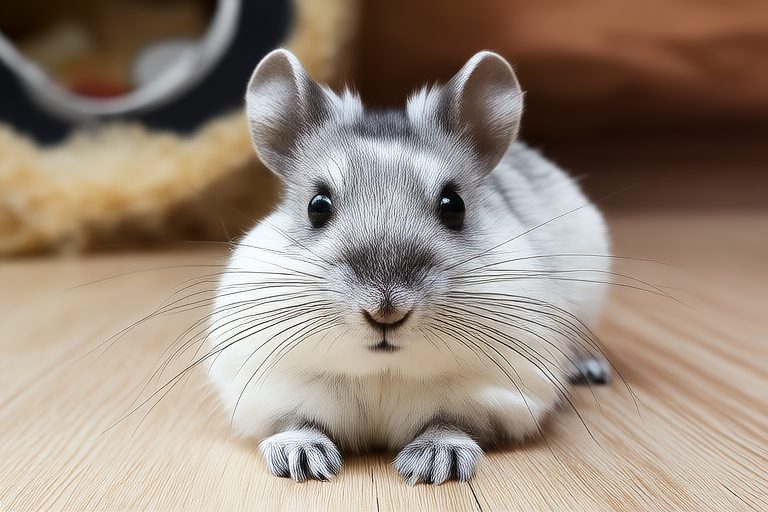Chinchilla Care: What Every First-Time Owner Needs to Know
Welcome to the wonderful world of chinchillas! These small, furry creatures are known for their soft, luxurious fur and playful personalities. If you’re a first-time owner or considering adopting one, this guide will help you understand the essentials of chinchilla care. From diet and habitat setup to grooming and health concerns, we’ve got you covered. Let’s dive into what every new chinchilla owner needs to know.
Diet: Feeding Your Chinchilla Properly
Chinchillas have specific dietary needs that ensure they remain healthy and happy. Their diet should primarily consist of hay, which provides essential fiber for digestion. Timothy hay is the most recommended type, but orchard grass hay can also be offered. Fresh water should always be available, as dehydration can lead to serious health issues.
In addition to hay, chinchillas require a high-quality pellet mix designed specifically for them. Avoid pellets containing seeds, nuts, or dried fruit, as these can cause obesity and other health problems. Treats like raisins or dried rose hips should be given sparingly, no more than a few pieces per week. It’s important to consult with a veterinarian specializing in exotic pets to ensure your chinchilla’s diet is balanced and appropriate.
Habitat Setup: Creating a Comfortable Home
A proper habitat is crucial for your chinchilla’s comfort and well-being. The cage should be large enough to allow for movement and play. A minimum size of 3 feet by 2 feet by 4 feet is recommended for a single chinchilla. Multi-level cages with ramps and platforms are ideal, providing opportunities for exercise and exploration.
The substrate at the bottom of the cage should be safe and absorbent. Aspen shavings or paper-based bedding are suitable options. Avoid pine or cedar shavings, as they can irritate the respiratory system. Place the cage in a quiet area away from direct sunlight and drafts. Chinchillas are sensitive to temperature changes, so maintain a room temperature between 60°F and 70°F (15°C to 21°C).
Grooming Requirements: Maintaining Your Chinchilla’s Fur
One of the most notable features of chinchillas is their thick, plush fur. Regular dust baths are necessary to keep their coat clean and healthy. Provide a shallow container filled with commercial chinchilla dust twice weekly for approximately 15 minutes. After the bath, remove any excess dust from the chinchilla’s fur.
Chinchillas do not need to be brushed frequently, as over-grooming can damage their delicate fur. Instead, focus on checking for signs of matting or parasites during handling. Regular nail trims may also be required, especially if the chinchilla spends much time indoors without access to abrasive surfaces.
Health Concerns: Keeping Your Chinchilla Healthy
Regular veterinary check-ups are essential for monitoring your chinchilla’s health. Common health issues include dental problems, respiratory infections, and digestive disorders. Signs of illness might include lethargy, loss of appetite, difficulty breathing, or changes in fecal output.
To prevent health problems, ensure your chinchilla has access to fresh food and water daily. Clean the cage thoroughly at least once a week, removing all bedding and replacing it with fresh material. Monitor your chinchilla’s behavior and weight regularly. Early detection of any issues can significantly improve outcomes.
Behavioral Insights: Understanding Your Chinchilla
Chinchillas are naturally curious and active animals. They enjoy exploring their environment and interacting with toys. Providing a variety of safe items such as cardboard boxes, tunnels, and wooden chew toys can stimulate mental and physical activity. Rotate toys periodically to maintain interest.
Chinchillas are crepuscular, meaning they are most active during dawn and dusk. This can make them seem less active during the day, but they often become more playful in the evening. Patience and gentle handling are key when introducing yourself to your chinchilla. Allow them time to get used to your presence before attempting to handle them.
Myths Debunked: Separating Fact from Fiction
There are several misconceptions about chinchillas that can lead to improper care. One common myth is that chinchillas require frequent bathing in water. In reality, chinchillas take dust baths to clean themselves, and excessive water exposure can lead to skin issues. Another misconception is that chinchillas can live in smaller cages. While some may survive in cramped spaces, they thrive in larger environments that allow for natural behaviors.
It’s also important to note that chinchillas do not hibernate. They are active year-round and require consistent care and attention. By understanding these truths, you can better meet your chinchilla’s needs and provide a fulfilling life.
Creating a Stimulating Environment
Enrichment is vital for keeping your chinchilla mentally and physically engaged. Offer a variety of activities that challenge them, such as puzzle feeders or hiding treats around the cage. Rotate toys and add new elements occasionally to prevent boredom. Interactive sessions with you can also be beneficial, fostering trust and strengthening your bond.
Consider setting up a play area outside the cage where your chinchilla can explore under supervision. Ensure the space is safe and free from hazards like electrical cords or small objects that could be swallowed. Supervised playtime allows for social interaction and physical exercise, contributing to overall well-being.
Maintaining Your Chinchilla’s Well-Being
By following these guidelines, you can ensure your chinchilla enjoys a long, healthy, and happy life. Remember, each chinchilla is unique, so observe their individual preferences and adjust care accordingly. Stay informed about advancements in chinchilla care and consult with professionals when needed. With dedication and love, you’ll create a nurturing home for your cherished pet.
For further reading and resources, consider books like “The Complete Guide to Chinchillas” by Karen Wyrick or joining online communities dedicated to chinchilla owners. These resources offer valuable insights and support throughout your journey as a chinchilla caregiver.
